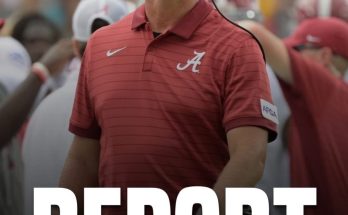The ongoing tension between Ohio State and Notre Dame football lore added a new chapter when Lou Holtz, the legendary Notre Dame coach, reignited his feud with Buckeyes head coach Ryan Day by once again questioning the greatness of the Ohio State program. Holtz, who has not shied away from making strong and often pointed remarks about the Buckeyes, recently used his platform to cast doubt on their legitimacy as a powerhouse program after a hard-fought 14-7 victory over Texas. This sparked plenty of reactions across the college football world, but what came as a surprise to many was that a former Michigan man, Jake Butt, came to Day’s defense in an unlikely show of respect across one of the sport’s fiercest rivalries. Butt’s defense of Day offered a fascinating glimpse into the broader debates surrounding legacy, toughness, and what truly defines greatness in the modern college football era, especially at a time when narratives and reputations can shift dramatically based on just a few key games.
For context, the tension between Lou Holtz and Ryan Day began in earnest a year earlier, when Holtz suggested Ohio State lacked the physicality and toughness to beat elite opponents. His comments before the Buckeyes’ game against Notre Dame ignited a storm, especially after Day fired back following a dramatic win over the Irish, passionately defending his players and calling out Holtz directly in a fiery postgame interview. That viral moment painted the feud as one between the old guard of college football, represented by Holtz, and the new era embodied by Day. Since then, Holtz has continued to take jabs at Ohio State whenever the opportunity arises, framing his critiques around questions of grit, resilience, and what it means to be a “great” football team.
When Ohio State narrowly edged out Texas 14-7, a win that was ugly on offense but impressive defensively, Holtz resurfaced with fresh commentary. He claimed that Ohio State, despite their victory, had once again revealed their flaws and therefore did not measure up to the historical standard of greatness. In his view, the Buckeyes relied too much on talent rather than heart, and he hinted that teams like Alabama, Georgia, or even Michigan embodied more of the qualities he believes define a true championship-caliber team. This latest critique struck a nerve because, while Ohio State continues to post impressive win totals and recruit at an elite level, questions about their toughness and ability to finish seasons with national titles persist, especially after high-profile losses in recent playoff runs.
What made this round of commentary especially interesting was the defender who emerged—Jake Butt, a former tight end at Michigan. Butt is not only a proud Michigan alumnus, but he is also someone deeply ingrained in the identity of a program that relishes every opportunity to criticize Ohio State. The Buckeyes-Wolverines rivalry is the most heated in all of college football, filled with a century of animosity, cultural clashes, and stakes that often determine the trajectory of entire seasons. For Butt to speak up in defense of Ryan Day, a coach who is often portrayed as the enemy in Ann Arbor, immediately raised eyebrows and showed that some debates go beyond even the fiercest rivalries.
Butt argued that Holtz’s repeated critiques of Day were outdated, unfair, and missed the broader picture of modern college football. He acknowledged the rivalry between Michigan and Ohio State but emphasized respect for what Day has accomplished since taking over the Buckeyes. Butt pointed out that Day inherited massive expectations from Urban Meyer, yet has managed to keep Ohio State consistently in the national championship conversation, recruit at the highest levels, and adapt to an evolving game that looks much different from Holtz’s era. According to Butt, to continuously question Day’s toughness and leadership ignores the reality of how difficult it is to stay near the top in today’s hyper-competitive landscape.
One of Butt’s most compelling points was about the evolution of the sport itself. Holtz, who coached in the 1980s and 1990s, came from a time when college football was dominated by power formations, smashmouth football, and a narrower talent pool. In that era, measuring “toughness” was often about who could run the ball 40 times a game and dominate in the trenches. Today’s game, by contrast, is marked by spread offenses, high-tempo schemes, and a much more balanced distribution of talent across the country. Butt suggested that criticizing Day for not fitting an old-school definition of toughness is misguided because the game has changed dramatically. Toughness today can be measured in different ways, such as the ability to execute under pressure, rally back from adversity, and sustain success despite relentless scrutiny.
Butt also drew attention to the fact that Ohio State’s win over Texas showcased elite defensive toughness, holding one of the most talented offensive units in the country to just seven points. To him, dismissing that kind of performance as insufficient toughness ignores the evidence on the field. He emphasized that a win is a win, and in college football, where the margin of error is razor-thin, beating another top-ranked team on the national stage deserves respect regardless of the final scoreline. In defending Day, Butt essentially argued that the bar set by critics like Holtz is not only unfair but also nearly impossible to meet in the modern era, where parity and pressure have reached unprecedented levels.
Beyond the specifics of the Day-Holtz feud, Butt’s comments touched on something larger—how generational divides shape debates about sports. Holtz represents an era when coaches were almost mythic figures, dictating culture with an iron hand and defining programs for decades. Day represents the modern coach who has to juggle not just Xs and Os but also recruiting battles, media scrutiny, NIL negotiations, and transfer portal chaos. To expect Day, or any modern coach, to fit the same mold as legends of the past is to misunderstand the evolution of the role. Butt, as a younger voice who has played in the modern game, seemed to recognize this divide clearly, while Holtz continues to hold onto an outdated framework.
Another fascinating dimension is how Butt’s defense of Day highlights the possibility of respect across rivalries. The Michigan-Ohio State rivalry is brutal, but Butt’s willingness to stand up for a rival coach suggests that even within the intensity of that relationship, there is space for fairness. Butt has no reason to blindly defend Day—if anything, his Michigan ties might incline him to remain silent or even pile onto Holtz’s critique. But instead, he chose to acknowledge Day’s success and push back against what he viewed as unfair treatment. In doing so, he modeled a kind of sportsmanship and perspective that can sometimes be lost amid the heated narratives of college football.
Of course, not everyone in the Ohio State or Michigan camps will view Butt’s comments positively. Some Ohio State fans may see it as faint praise or wonder why they need validation from a Michigan alum at all, while some Michigan fans may bristle at the idea of defending their biggest rival. But the broader college football community has largely praised Butt for his balanced and reasoned perspective. His defense doesn’t absolve Day of the challenges he faces—particularly the pressure to win national championships—but it does serve as a reminder that success in college football is about more than just fitting one rigid definition of toughness.
At the heart of this entire discussion is Ryan Day himself, a coach who has lived under a microscope since the moment he replaced Urban Meyer. Day has produced an incredible record, developed multiple NFL quarterbacks, and kept Ohio State firmly in the playoff conversation. Yet his critics continue to point to his record against Michigan in recent years and the lack of a national title as evidence that he hasn’t fully lived up to expectations. Holtz’s critiques are simply the loudest expression of a sentiment that has circulated among fans and pundits. But as Butt rightly points out, such criticisms sometimes overlook the realities of the modern game and the difficulty of sustaining elite performance year after year.
In many ways, the Day-Holtz feud—and now Butt’s entry into it—illustrates the clash of eras in college football. Holtz represents the nostalgia of a bygone time, one where dominance was defined in simpler terms, while Day represents the complexities and pressures of the sport today. Butt, bridging these perspectives as a recent player and commentator, provides a refreshing and thoughtful middle ground that respects both sides but ultimately defends fairness. His defense of Day may not silence Holtz, who seems intent on continuing his pointed critiques, but it adds a layer of nuance to the conversation and forces fans to reconsider how they evaluate coaches in the modern era.
Looking ahead, this debate is unlikely to end anytime soon. As long as Ohio State continues to win big games but falls short of ultimate titles, critics will continue to question Day’s leadership, and Holtz will likely resurface whenever the Buckeyes find themselves in the spotlight. But Butt’s defense reminds us that success should be measured with a wider lens, one that takes into account not just results but also the context of the game as it exists today. For all the rivalry and animosity that defines Michigan and Ohio State, there is room for respect, and Butt’s words demonstrate that even in the most heated of sports rivalries, fairness and perspective can still break through.
The larger lesson here is about how we judge greatness in sports. Is it only about championships? Is it about style, toughness, or dominance? Or is it about consistency, adaptability, and the ability to thrive in one of the most competitive environments imaginable? These are the questions at the heart of the debate between Holtz, Day, and now Butt. While the answers may differ depending on who you ask, what remains clear is that the conversation is far from over. For Ohio State, for Ryan Day, and for college football as a whole, this feud continues to reflect deeper tensions about tradition, change, and the ever-evolving definition of greatness.



